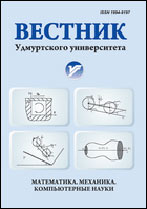|
This article is cited in 8 scientific papers (total in 8 papers)
MECHANICS
Modeling the flow of a multicomponent reactive gas using high accuracy algorithms
R. V. Zhalnina, E. E. Peskovaa, O. A. Stadnichenkob, V. F. Tishkinc
a Ogarev Mordovia State University, ul. Bol'shevistskaya, 68, Saransk, 430005, Russia
b Boreskov Institute of Catalysis, Siberian Branch of the Russian Academy of Sciences, pr. Lavrentieva, 5, Novosibirsk, 630090, Russia
c Keldysh Institute of Applied Mathematics, Russian Academy of Sciences,
Miusskaya pl., 4, Moscow, 125047, Russia
Abstract:
The article considers a high-order accuracy algorithm for modelling the dynamics of multicomponent reactive gas taking into account the processes of diffusion, thermal conductivity and chemical reactions, based on WENO schemes. Computations for gas flow in a flowing reactor for thermal ethane pyrolysis with external heating of the reaction zone are carried out. The velocity of gas motion in explored flows is much less then sound velocity in gas mixture, which motivates using the Navier–Stokes equations in approximation of low Mach numbers for describing the processes under study. Computation of chemical kinetics equations is singled out as a separate step. The velocity of chemical reactions is defined by Arrhenius expressions. The ethane pyrolysis kinetic scheme is used for constructing the model, which is a branched radical mechanism. Computations of subsonic gas flow taking into account the processes of diffusion, chemical reactions and their thermal effects for different temperature of heating elements are carried out. Comparison with experimental data shows that $1.97\,\%$ conversion of ethane is reached at $648^{\circ}$C at the outflow of metal reactor. This result is close to $2.1\,\%$, which is obtained by experiment. Comparison of experimental data of thermal ethane pyrolysis with numerical experimental data shows a high level of reliability of the results obtained.
Keywords:
Navier–Stokes equations, weno scheme, pyrolysis of ethane.
Received: 18.10.2017
Citation:
R. V. Zhalnin, E. E. Peskova, O. A. Stadnichenko, V. F. Tishkin, “Modeling the flow of a multicomponent reactive gas using high accuracy algorithms”, Vestn. Udmurtsk. Univ. Mat. Mekh. Komp. Nauki, 27:4 (2017), 608–617
Linking options:
https://www.mathnet.ru/eng/vuu612 https://www.mathnet.ru/eng/vuu/v27/i4/p608
|

| Statistics & downloads: |
| Abstract page: | 432 | | Full-text PDF : | 226 | | References: | 50 |
|




 Contact us:
Contact us: Terms of Use
Terms of Use
 Registration to the website
Registration to the website Logotypes
Logotypes








 Citation in format
Citation in format 
